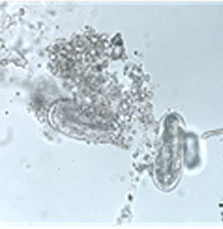Potential of Combination of Trichoderma asperellum strain Cb-pin01 and Streptomyces sp. Strain KPS-E004 in Controlling M. enterolobii of Chili
Keywords:
Root-knot nematode in chili, biocontrol, Trichoderma sp., Streptomyces sp.Abstract
Meloidogyne enterolobii causes significant yield loss in chili (Capsicum frutescens L.). This research investigated the control potential of co-inoculation of chili with the T. asperellum strain Cb-pin01 and Streptomyces sp. strain KPS-E004 on the growth and symbiotic performance of M. enterolobii challenged chili. From the results of laboratory tests, the mixture of two strains reduced the egg hatch rate, increased the juvenile mortality rate and inhibited root penetration of infective second-stage juvenile of M. enterolobii up to 75.33%, 62.44% and 98.67%, respectively when compared to the control. The test with peppers in greenhouse conditions revealed that the mixture of two strains reduced the number of egg mass, reduced the number of second-stage juveniles in soil and suppressed root knot disease up to 71.05%, 75.68% and 50%, respectively when compared to positive control. The control efficiency of co-inoculation of both strains in suppressing root knot disease also increased up to 150.02% as compared to inoculation of single strain of Cb-pin01. Moreover, the mixtures promoted the growth of chili by increasing the shoot weight, shoot and root length and improving the yield of extra-large chili by 129.65%, 139.63%, 122.89% and 165.51%, respectively (compared to negative control). Based on the results of this study, T. asperellum strain Cb-pin01 and Streptomyces sp. strain KPS-E004 may apply together to control root-knot disease in chili plants.
References
กรมวิชาการเกษตร. 2562. สถานการณ์การผลิตพริก. แหล่งที่มา: https://www.doa.go.th/hort/wp- content/uploads/2020/10.pdf,24 กรกฎาคม 2565.
จิระเดช แจ่มสว่าง และวรรณวิไล อินทนู. 2545. การผลิตเชื้อราไตรโคเดอร์มาชนิดสดด้วยเทคนิคอย่างง่ายเพื่อใช้
ควบคุมโรครากเน่าระดับดินของถั่วฝักยาวที่เกิดจากเชื้อรา Sclerotium rolfsii. ใน: การประชุมวิชาการของมหาวิทยาลัยเกษตรศาสตร์ ครั้งที่ 40. 4-7 กุมภาพันธ์ 2545. กรุงเทพฯ.
ชนากานต์ บุญรินทร์, บัญชา ชิณศรี, อนงค์นุช สาสนรักกิจ และศรีเมฆ ชาวโพงพาง. 2562. จัดจําแนกไส้เดือน
ฝอยรากปม (Meloidogyne enterolobii) ในแปลงปลูกพริกที่จังหวัดอุบลราชธานี, น. 713-722. ใน: การประชุมวิชาการเสนอผลงานวิจัยระดับบัณฑิตศึกษาแห่งชาติ ครั้งที่ 20. 15 มีนาคม 2562. มหาวิทยาลัยขอนแก่น, ขอนแก่น.
Affokpon, A., D. L. Coyne, C. C. Htay, R. D. Agbèdè, L. Lawouin and J. Coosemans. 2011. Biocontrol potential of native Trichoderma isolates against root-knot nematodes in West African vegetable production systems. Soil Biology and Biochemistry 43(3): 600-608.
Barker, K.R.1985. Nematode extraction and bioassays, pp.29-30. In: K.R. Barker, C.C. Carter and J.N. Sasser (Eds.). An Advanced Treatise on Meloidogyne, vol II., North Carolina State University
Graphics, Raleigh, North Carolina.
Byrd, D.W. Jr., T. Kirkpatrick and K.R. Barker. 1983. An improved technique for clearing and
staining plant tissue for detection of nematodes. Journal of Nematology 15:142-143.
Chamswarng, C., W. Intana and P. Yenjit. 2014. Efficacy of Trichoderma harzianum, Bacillus cereus and their lytic enzymes for the control of damping-off disease of yard long bean caused
by Pythium aphanidermatum. The Philippine Agricultural Scientist 96: 377-383.
Hunt, D. J. and Z. A. Handoo. 2009. Taxonomy, identification and principal species. pp. 55-97. In:
Root-knot Nematodes. CAB International. Wallingford.
Hashem, M. and K. A. Abo-Elyousr. 2011. Management of the root-knot nematode Meloidogyne
incognita on tomato with combinations of different biocontrol organisms. Crop Protection 30(3): 285-292.
Jindapunnapat, K. 2012. Development of the Molecular Markers for Species Identification of Root-knot Nematode Infesting Guava in Thailand. M.S. Thesis, Kasetsart University.84 P.
Jindapunnapat, K., B. Chinnasri and S. Kwankuae. 2013. Biological control of root-knot nematodes (Meloiodogyne enterolobii) in guava by the fungus Trichoderma harzianum. Journal of Developments in Sustainable Agriculture 8: 110-118.
Ruanpanun, P. and C. Chamswarng. 2016. Potential of actinomycetes isolated from earthworm
castings in controlling root-knot nematode Meloidogyne incognita. Journal of General Plant Pathology 82(1): 43-50.
Ruanpanun, P., N. Tangchitsomkid, K. D. Hyde and S. Lumyong. 2010. Actinomycetes and fungi
isolated from plant-parasitic nematode infested soils: screening of the effective biocontrol potential, indole-3-acetic acid and siderophore production. World Journal of Microbiology and Biotechnology 26(9): 1569-1578.
Sahebani, N. and N. Hadavi. 2008. Biological control of the root-knot nematode Meloidogyne javanica by Trichoderma harzianum. Soil Biology and Biochemistry 40(8): 2016-2020.
Sun, M. H., L. Gao, Y. X. Shi, B. J. Li and X. Z. Liu. 2006. Fungi and actinomycetes associated with
Meloidogyne spp. eggs and females in China and their biocontrol potential. Journal of
Invertebrate Pathology 93(1): 22-28.
Tigano, M., K. De Siqueira, P. Castagnone-Sereno, K. Mulet, P. Queiroz, M. Dos Santos, C.
Teixeira, M. Almeida, J. Silva and R. Carneiro. 2010. Genetic diversity of the root-knot
nematode Meloidogyne enterolobii and development of a SCAR marker for the guava-
damaging species. Plant Pathology 59:1054–1061.






